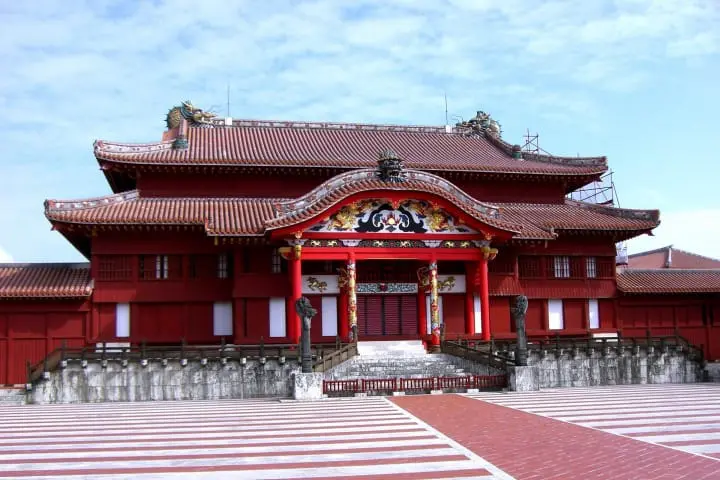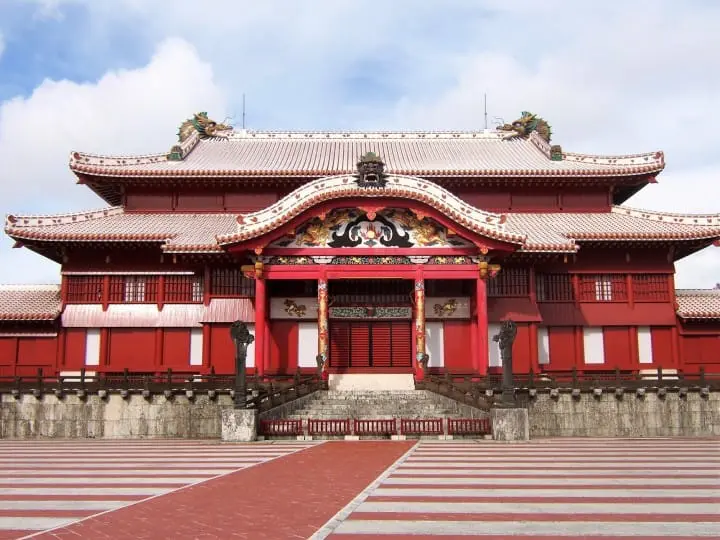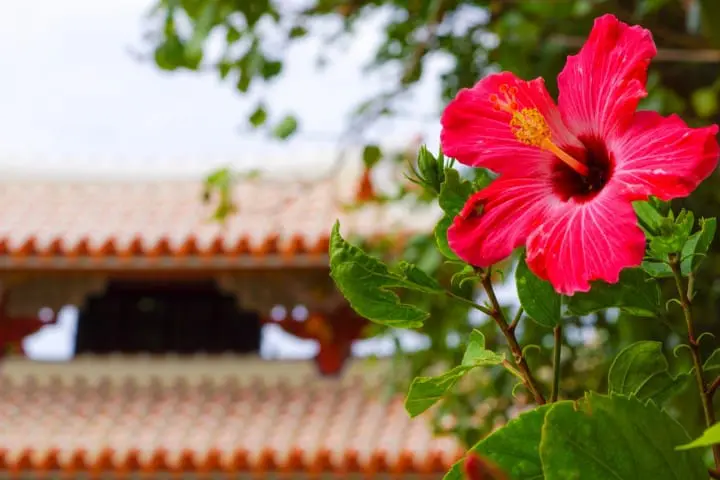Shuri Castle, Okinawa: Highlights, Access, And Events (2019)

Shuri Castle is the largest castle in Okinawa and a World Heritage site. It was the palace of the Ryukyu Kingdom and served as the heart of Okinawan political and cultural life. Find out about events, must-see spots, and how to access the castle.
Update from November 5, 2019.
Shuri Castle was lost in a devastating fire on October 31, 2019. Parts of the Shurijo Castle Park are, however, open to the public. For details, please check the official website.
Shuri Castle: The Historical Center of Okinawa

Shuri Castle, located in the Shuri neighborhood of Naha City, is the largest castle in Okinawa. Although most of the castle was destroyed in World War II, it was restored to its original state in 1992.
In 2000, the intact section of the castle that did not undergo any repairs became a registered world heritage site under the name of Shuri Castle.
The castle originally served as the palace of the Ryukyu Kingdom during its 450-year-long rule over Okinawa between 1429 and 1879.
The Ryukyu Kingdom established a theocracy, striving to centralize the politics and religion. Therefore, Shuri Castle was a multi-purpose building used as the residence of the royal family, as an administrative body, and center for religious matters. Shuri Castle was truly the heart of Okinawan political and cultural life.
Read on to learn how to access Shuri Castle, must-see spots, and events at this symbolic site.
Shuri Castle - Highlights
One of the exquisite characteristics of Shuri Castle is its architecture that combines Chinese and Japanese designs. The blending of these two architectural designs results in the distinctive Okinawan style.
Other noticeable features are its red walls and tiles, pillars engraved with dragon motifs, as well as unique materials and decorations you won’t find in other Japanese castles.
You’ll also notice that there is no tenshu (main tower, *1). The contrast between the blue Okinawan sky and bright red Shurijo Castle will surely inspire you to capture this scenery in a beautiful photo.
*1 Tenshu: the tallest structure in a Japanese castle. It is also the symbol of a castle.
Shureimon: A Symbol of the Ryukyu Kingdom

©︎JNTO
Shureimon is the most prominent structure of the Shuri Castle. In fact, the word “shuri” means to “protect the decorum.”
The name originates from the words—“shurei no kuni”—inscribed on the upper part of the gates, which serve as proof of how much importance the Ryukyu Kingdom placed on etiquette.
Seiden: The Symbol of Shuri Castle

Seiden is the castle’s central building. Its characteristic design is a two-layer structure with three floors. This can be quite confusing to an observer who sees only two floors when in actuality there are three.
To protect the buildings from harsh sunlight, the artisans used tung oil and red pigment (bengala) on the walls, which resulted in the castle's distinct crimson look.
Inside the seiden, you can admire replicas of the king’s throne and queen's quarters, respectively coined "Usasuka" and "Ufugui" in Japanese.
The plaza you can see in the front part of the picture is called una. This is where many ceremonies took place during the Ryukyu Kingdom's rule.
Ukejo: A Daily Morning Event
Every morning from 8:25 to 8:45, there is a special opening ceremony of the castle gates. The gates open when the castle officials hit a bronze gong while bellowing “Ukejo!”
For about 15 minutes after the gates open, visitors can enjoy traditional Ryukyuan music playing through the speakers and reminiscence of the Ryukyu Kingdom's golden age. The traditional apparel worn by the castle staff is also the same attire worn during this period. Use this opportunity to ask the staff for a photograph that would make a lasting memory of your visit.
Shuri Castle - Basic Information

Since the castle was built on top of a small hill, the entire hill is considered and maintained as Shurijo Castle Park. The park consists of both free and paid admission areas.
While some of the gates at the foot of the hill are free of charge, the main castle structures require an entrance fee to visit.
Operating Hours
Although the paid admission area always opens at 8:30, the closing time varies on the season. The final sale of admission tickets is 30 minutes before closing time.
Closing Time
April-June: 19:00
July-September: 20:00
October-November: 19:00
December-March: 18:00
The free area is open year-round at 8:00 and closes 30 minutes after the paid admission area. Shurijo Castle Park is closed on the first Wednesday and following day in July.
Admission Fees
The admission fees for the paid area are as follows: adults 820 yen; high school students 620 yen; elementary/junior high school students 310 yen; and children 6-years-old and younger are free of charge.
Those who have a free pass for the Okinawa Monorail (Yui Rail) simply have to show it at the ticket counter to receive a discount (adults 660 yen; high school students 490 yen; and elementary/junior high school students 250 yen).
Access to the Shuri Castle

Here’s how to reach Shuri Castle from Naha Airport: the hub airport of Okinawa. Ride the Yui Rail train bound for Shuri at Naha Airport Station and get off at Shuri Station.
The ride takes approximately 30 minutes and costs 330 yen. From Shuri Station, it takes 15 minutes on foot to arrive at Shuri Castle.
In case you’re wondering how to reach Okinawa from a certain area in Japan, check out the following article for detailed instructions: How To Travel To Okinawa From Japan’s Major Cities
Seasonal Events at Shuri Castle (Year 2019/2020)
January: Shinshun no Utage (The New Year's Banquet)
This is a reenactment of the New Year's celebration held in the Ryukyu Kingdom. One of the highlights of the celebration is the imperial court dance.
Schedule: January 1 (Wednesday, public holiday) - January 3 (Friday), 2020
Time: 8:30 to 17:00
October to November: Shuri Castle Festival
There are two main events at the Shuri Castle Festival, which is held from late October to early November. The first one refers to the Ryukyu Kingdom Emaki Gyoretsu Procession, where people dressed in the traditional Ryukyu attire promenade down Kokusai-dori street in Naha. The second is the Koshiki (Traditional) Gyoretsu Procession, which is another reenactment of the Ryukyu Kingdom's traditional rites. These are great opportunities to get in touch with the unique traditions of Okinawan culture.
Ryukyu Kingdom Emaki Gyoretsu Procession
Schedule: October 27, 2019 (Sunday)
Time: 12:30 to 14:30
Location: Kokusai-dori, Naha
Koshiki (Traditional) Gyoretsu Procession
Schedule: November 2, 2019 (Saturday)
Time: 12:50 to 15:30
Location: Inside the Shuri Castle (Hoshinmon, Shureimon, Ryutan-dori street)
Thousands of candles are also lit up during the illumination event on October 26 and 27, 2019 from 17:00 until 21:00.
November: Momoso Omono Mairi
This is a traditional ceremony in which priestesses prayed for the king's longevity as well as the perpetuation of his descendants, the country's stability, and prosperous crops. A priestess wearing traditional white clothes will walk around the Shuri Castle and pray in the vicinity.
Schedule: November 23 (Saturday)-November 24 (Sunday), 2019
Time: 12:00-13:00/15:00-16:00
Enjoy Your Visit to Okinawa

Will you be heading to Okinawa, the southernmost part of Japan? If so, make sure you have all the necessary equipment to stay safe from sunburn and heatstroke. There's no time to waste while discovering the tourism gems of Okinawa!
Read also
Hotels near Shurijo Castle Park
Originally written by: Mayu
This is the official account of MATCHA's editorial department. Our articles feature useful travel information for visitors to Japan, from how-to guides to recommended places to visit.














































![[Coupon Available] Attention Overseas Winter Sports Fans! Nagano's Sports Depot Has Evolved](https://resources.matcha-jp.com/resize/720x2000/2026/01/05-254819.webp)
![[2 hours from Tokyo ] 10 Quiet and Breathtaking Views of Mount Fuji in Yamanashi Hokuto City , Yamanashi - Part 2](https://resources.matcha-jp.com/resize/720x2000/2025/12/16-253037.webp)

![[Reopening in March 2026] Ikoma Sanjo Amusement Park Park, 45 minutes from Osaka , with free admission](https://resources.matcha-jp.com/resize/720x2000/2024/08/28-194409.webp)